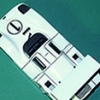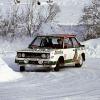The polycarbonate (plexigtlass) of choice in the period that interests you was Lexan by GE. Lexan was relatively expensive compared to competitors but in the greater scheme of things the cost difference made little differnce.
Lexan was the material of choice because it was highly formable and practically unaffected by things that would cause breakages and/or scratches.
Best of all it was the clearest product of the day. Yellowness and haziness factors were lower than 1%. It also did not yellow with age as cheaper products did. I used Lexan on my BT15 rebuild in 1971. I recently sold the car and the windscreen was as clear as the day installed.
Lexan was even more widely used in aircraft than in race cars due to freedom from breakiage and scratching.
If one digs back into old copies of Autocmobile Year from the period you can get a good idea as to who was using Lexan and who was using cheaper substitutes. The beauty of Automobile Year is that they used the highest quality of photos and printing and paper quality so what we see today is at it was. Other documents of the day give poor visuals by comparison due to ink and paper deterioration; all assuming that they were of accurate quality on the day they were printed.
Referring to several copies of Automobile Year I am surprised how many cars had hazy screens compared to competitors in the same frame of photos. I can't tell whether the haze is poor quality product or tinting. I don't see any that are particulalrly yellow.
Regards




















